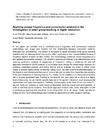Applying corpus linguistics and conversation analysis in the investigation of small group teaching in higher education (Pre-published version)
Citation
O’Keeffe, A. and Walsh, S. (2012) “Applying corpus linguistics and conversation analysis in the investigation of small group teaching in higher education”. Corpus Linguistics and Linguistic Theory, 8(1): 159–181.

View/
Date
2012Author
O'Keeffe, Anne
Walsh, Steve
Peer Reviewed
YesMetadata
Show full item record
O’Keeffe, A. and Walsh, S. (2012) “Applying corpus linguistics and conversation analysis in the investigation of small group teaching in higher education”. Corpus Linguistics and Linguistic Theory, 8(1): 159–181.
Abstract
In this paper, we consider how a combined corpus linguistics and conversation analysis methodology can reveal new insights into the relationship between interaction patterns, language use, and learning. The context of the paper is higher education small group teaching sessions and our data are drawn from a one million word corpus, the Limerick-Belfast Corpus of Academic Spoken English (LI-BEL CASE). Our methodology combines corpus linguistics (CL) and applied conversation analysis (CA), enabling quantitative findings to be elaborated by more close-up qualitative analysis of sequences of interaction. Using a combined CL and CA approach (henceforth CLCA) enables us to consider more closely the relationships between, for example, interaction patterns and lexical chunks and to evaluate the extent to which tutors create or prevent opportunities for learning. Using CLCA, we offer a more detailed description of the linguistic and interactional features of turns at talk and consider how these features combine in the joint enterprise of meaning-making. Put simply, CLCA enables us to characterize seminar talk in a more systematic way. Starting at the level of turn, and using CA to move to a higher level of discourse, we can identify specific features of the spoken interaction, such as sequential organisation and topic management. Similarly, starting again at the level of turn but using CL, we can move our analysis to lower levels of discourse, such as cluster and word patterns, in order to see how words combine. This CLCA approach offers a fuller, richer description of talk in small-group teaching than would be found using either CA or CL alone. Finally, we offer an evaluation of a CLCA methodology and consider its applications in other research settings.
Keywords
Corpus linguisticsConversation
Analysis
Investigation
Small group teaching
Higher education
Language
CA
CL
Analysis

